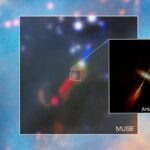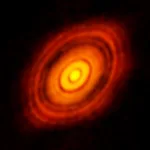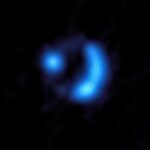De eerste stapjes van een babyster

The power of the Atacama Large Millimeter/submillimeter Array (ALMA) reveals two immense, rippled jets of dense gas with near-perfect symmetry emanating from a single source at the centre of this image. At their origin lies an extremely young star — called a protostar — that is beginning the long journey to becoming a star much like the Sun. The infant star, known as CARMA-7, and its jets are located approximately 1400 light-years from Earth within the Serpens South star cluster. This dense cluster, predictably found in the constellation of Serpens (The Serpent), is home to at least 30 more protostars that are sparking into existence in close proximity, providing astronomers with a perfect laboratory in which to study the interactions between stars and their environment. The first steps of a star’s life are still poorly understood, but astronomers concluded that these knotted, smoky jets are caused by periodic outbursts of gas, ejected at tremendous speeds from CARMA-7 into its surroundings. These outbursts are triggered by material infalling onto the protostar from an orbiting disc. As the jets speed away from their infant star, they collide with interstellar material causing them to slow and spread out. One day, that material may collapse and form yet another generation of stars.



